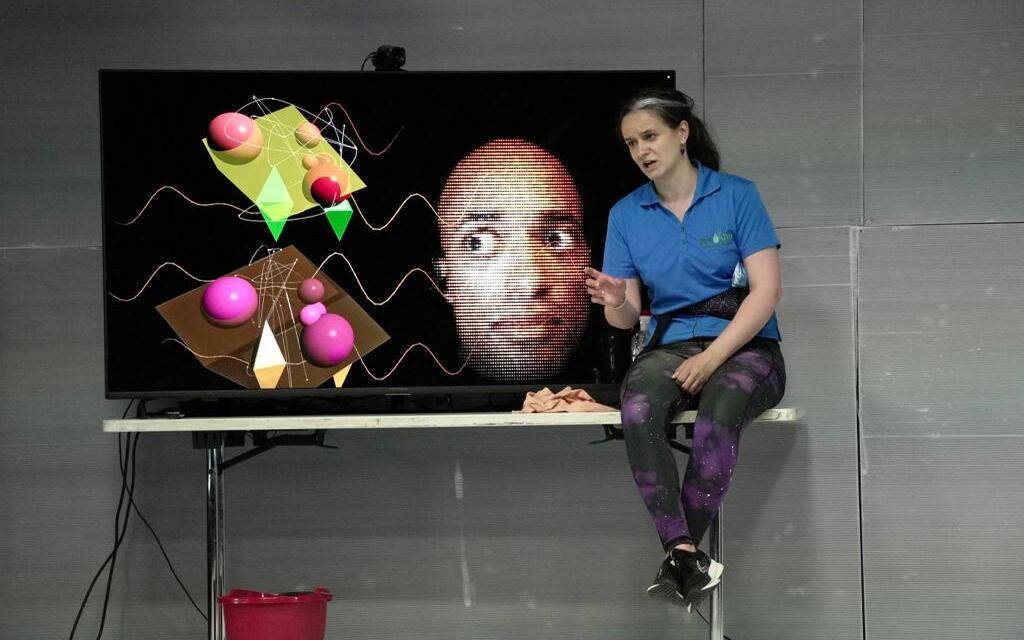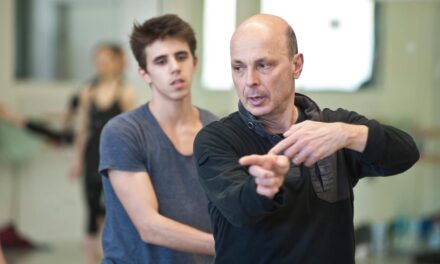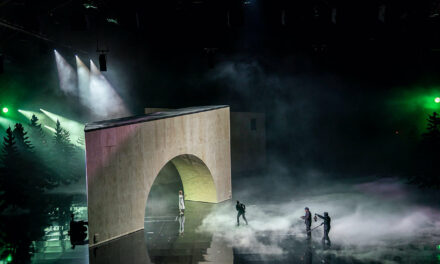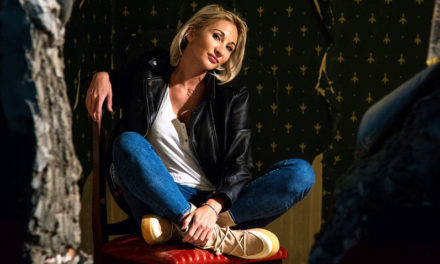Within the past six years, prominent Romanian playwright Saviana Stănescu has written two “AI plays” (What Happens Next, and ZEBRA 2.0) and the text for a dance theatre piece, E-Motion, co-created with Daniel Gwirtzman. All of them have been premiered in New York state.
As a New York based, international artist, Stănescu has developed a number of approaches to researching and crafting these multi-media pieces. In this in-depth interview, she reveals her inspiration, processes, and collaborative experiences.
Timeliness
Anne Hamilton: What prompted you to consider writing plays about artificial intelligence?
Saviana Stănescu: I’ve always been an avid reader of Sci-Fi books and watcher of Sci-Fi movies. The difference is that now AI is a reality in our lives, not just speculative fiction. There are hot debates about AI in the news, at parties, in boardrooms, and bedrooms. I have so many questions: Do we really understand how AI “thinks” and functions given the fact that we, humans, can’t process billions of data in a short time? Is AI going to take over humans? Should AI be regulated? Are people “feeding” copyrighted material to AI? Is AI a helpful, or a dangerous tool? It’s time for us—artists, playwrights, theatre makers—to have a say in this AI debate as well. It’s a rich topic to explore and an important conversation to have. We must participate in the process of shaping the future of human-AI relations.
Hamilton: What kinds of questions are you raising in these pieces? How are you expressing those questions in the play? Are you attempting to answer the questions?
Stănescu: As a former journalist during the Romanian Revolution against Ceaușescu’s dictatorial regime, I’ve always been concerned with questions about power dynamics, freedom of expression, and social/political rights. Recent advancements in neuroscience and generative AI made me obsess over the ethical aspects of the interaction between humans and (AI) machines. I’ve been trying to write dramatic texts that address these issues and make people aware of the wide range of their implications regarding human-AI connectivity.
Hamilton: What are the most compelling aspects of interpreting the topic of artificial intelligence in a dramatic work?
Stănescu: We are living in fascinating yet terrifying times. The Renaissance was one of those times that pushed humanity into the next level of creativity, and I feel that we are experiencing a similar yet enhanced/augmented era. Fire, Electricity, AI. That’s a powerful progression of human thought and discovery. What’s next? I don’t know, but I’m trying to make the most from living and writing in a time of major scientific breakthroughs. I feel we are moving forward with technological progress, but we are not living in peace and understanding, with tolerance and inclusion, unfortunately. Look at the wars and conflicts in various parts of the world.
Hamilton: Did you use your education and experience in computer programming to create these plays? How?
Stănescu: Yes, it was a full circle for me—using a bachelor’s degree and knowledge that I didn’t think I would ever employ after committing to a full-time life as an artist/playwright/theatre educator.
During the [Nicolae Ceaușescu] dictatorship, in Bucharest, I was a student in Computer Science because the humanities felt impregnated with propaganda, and I was good at both literature and math. It was exciting and grounding to find a solution to a difficult geometry problem at that turbulent time.
I studied journalism in college as well, and then worked for a daily newspaper called Adevărul [The Truth] in the 1990s. Then I came to the U.S. and completed an M.A. in Performance Studies and an M.F.A. and Dramatic Writing at New York University in early 2000s. I later earned a Ph.D. in Theatre at the National University of Theatre & Film in Bucharest in 2014. After enjoying a career as a playwright, and teaching playwriting and theatre studies for the last 20 years in the U.S., you can imagine that the last thing in my mind was computer programming.
However, I’m glad that in my recent plays I manage to connect my (beginner) knowledge of coding and neural networks with my (advanced) theatrical practice of creating innovative dramatic structures and characters. A friend called me a Renaissance woman, but I think I’m becoming an ”enhanced” one: Saviana 2.0, a writer who finally incorporates her lived experience and knowledge of performing arts, journalism, literature, and information technology, to bring something meaningful to this brave new world.
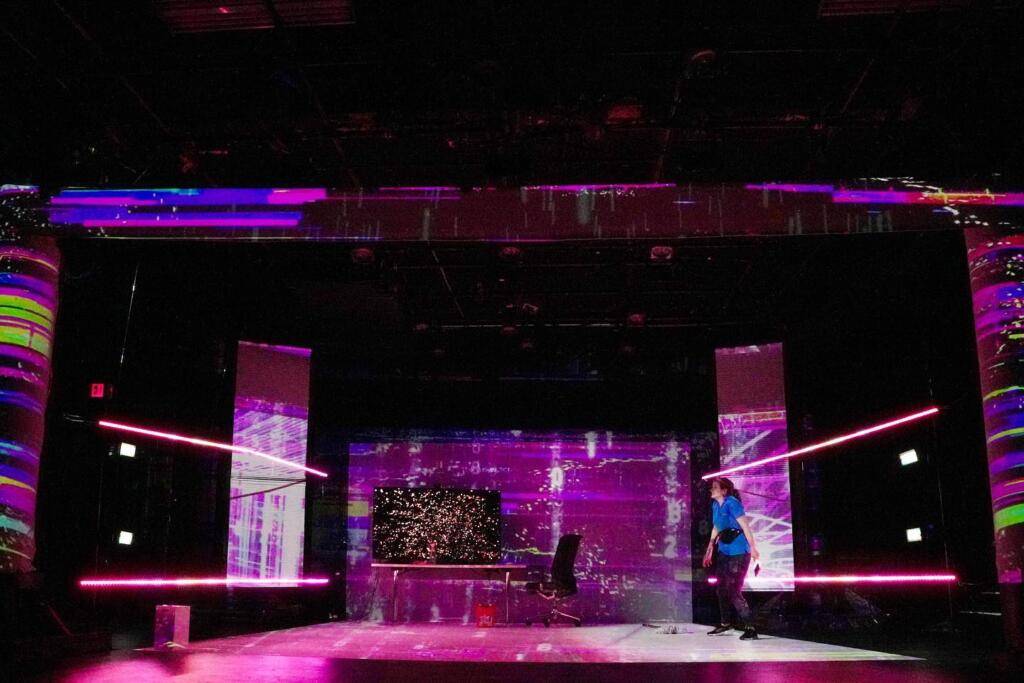
Actors Tim Craig and Alina Mihailevschi in ZEBRA 2.0 by Saviana Stanescu. Directed by Jeremy Goren at the New Ohio Theatre in the 2023 Ice Factory Festival. Photo by Jared Robertson.
Process
Hamilton: How did you conceive of these shows?
Stănescu: I have written two “AI plays” and the text for a dance theatre piece. All of them have been produced. They are: What Happens Next (The Cherry Arts, Ithaca, New York, 2017), ZEBRA 2.0 (Science in Theatre Festival, 2021, New York City and Ice Factory Festival, 2023, New York City), and e-Motion (co-created with Daniel Gwirtzman, co-produced by Daniel Gwirtzman Dance Company and The Cherry Arts in 2023). Daniel choreographed the piece, and performed in it, together with Sarah Hillmon.
What Happens Next is a Sci-Fi poetic thriller at the intersection of Black Mirror and Waiting for Godot (Godette?), with two women characters. Is one of them a robot, a clone, a hologram, an imaginary friend, a memory, a dream, a ghost? Which one? The audience needs to be kept guessing until the very end. Samuel Buggeln directed the premiere.
ZEBRA 2.0 is a play about the uncanny friendship between an AI who specializes in counting zebras in the wild, and the undocumented immigrant janitor who cleans “his” office. When I wrote the play three years ago, commissioned by the Science in Theatre Festival at The Tank in Manhattan, it was just me and my laptop during the pandemic. I wrote the play as a Sci-Fi immigrant rom-com. Now it’s not a Sci-Fi story anymore. Artificial Intelligence can do the things that I only imagined in 2020.
In ZEBRA 2.0 I took the utopian route—love, friendship, learning from each other. It’s still a rom-com, but with more serious undertones. Director Jeremy Goren brings an interesting transmedia concept to the production; there are video and data projections, an entire multi-media experience for the audience.
Daniel Gwirtzman and I serve on the faculty of Ithaca College’s School of Music, Theatre and Dance. In our dance theatre piece e-Motion, the story takes a dystopian turn (spoiler alert), as the AI rebels against its creator.
Hamilton: I have noticed that e-Motion is broken into several subheadings, and they all seem to be based on a particular logic. How did you come to create this flow?
Stănescu: Daniel and I talked a lot about the concept/story of e-Motion. On one level, e-motion = energy in motion. The term conveys multiple meanings, specifically, electric emotions/feelings that the robot/AI has, which are created via electric circuits and electrons in motion/connection with each other. It’s a good invented word for a dance theatre piece because it makes people think about dance, emotions, and electricity/electrons/computers/AI, all at the same time. This piece had to work as a dance performance and as a dramatic story. The subheadings helped develop the movement and the text. We knew very well what we were doing. We just had to find—each in our specific medium, but also together—the right form for the piece.
Referencing Frankenstein; or, The Modern Prometheus by Mary Shelley, our story follows the presentation of Ava, the neuroscientist, who has worked for decades to arrive at this moment. The main event is the big launch of the AI product, the “most-sophisticated” emotional AI, designed for scholarly and public consumption. The two characters are prepared with well-rehearsed e-motions for a perfect demonstration. But the AI has a different opinion.
Hamilton: How and why do you utilize repetitive phrasing?
Stănescu: It’s a writing style that I have been using in my poetry as well. Repetition can help the rhythm and language to be understood, while also establishing a routine/structure that will be broken later. Both ZEBRA 2.0 and e-Motion are organized in nights and days of workplace interactions: the human janitor cleans the AI’s office every night and they teach/learn from each other; and the neuroscientist teaches the AI and rehearses their presentation. The structure is episodic, and each story features a dramatic progression and a climax, as well as a reversal.
Hamilton: How did you organize your themes in e-Motion?
Stănescu: Our main themes include human-AI interaction, machine learning and the display of emotions, and the unexpected aspects of creating/educating/training a sophisticated AI.
One of the most exciting characteristics of the development of AI emotional expression is its potential to revolutionize the way we, humans, interact with machines. Our AI character, a humanoid robot called H (performed by Daniel Gwirtzman), is trained by Ava, the scientist, to perform/express a vast dataset of emotions, including the physiological and behavioral responses associated with each of them. This gives H the ability to recognize feelings and generate responses in real-time. We use a simulation/dance of human emotions in the progression of the story, as well as specific techno text which appears as projections and/or spoken word.
Hamilton: Did you use any processes of AI tech building during your process of working on this play? On this production? Which ones? How and what methods and processes did you employ in the collaboration?
Stănescu: Recent advances in AI technology have opened new possibilities for understanding and replicating emotional processes in machines, leading to the development of emotional AI systems that can interact with humans in a more natural and intuitive way. For instance, the humanoid robot Sophia, activated on February 14, 2016 by Hanson Robotics, is a charismatic international “ambassador” for AI. Sophia is “the world’s first robot citizen and Innovation Ambassador for the United Nations Development Program,” according to its developers.
We learned more and more about AI as we were doing research and sending each other videos and articles—it was a fascinating process because AI continued to evolve and surprise us.
Hamilton: Did your production process ever mirror the AI exploration/development processes in the play?
Stănescu: The spectrum of human feelings contains eight major emotions: sadness, shame, disgust, anger, fear, startle/surprise, excitement/joy, and love/trust. We worked with those emotions when developing the concept and story for e-Motion. The main technique used in “educating” AI is deep learning, which is a type of machine learning that involves training artificial neural networks to learn and recognize patterns in data. Deep learning algorithms are designed to mimic the structure and function of the human brain, allowing them to process large amounts of data and extract meaningful information from it. Those facts inform the narrative and performance.
Hamilton: You stated in an earlier interview that, “ChatGPT worked with us on e-Motion as a research assistant.” How did that process unfold?
Stănescu: I asked ChatGPT various questions and gave prompts connected to our themes—the neuroscience of emotions, robot-human interaction, Mary Shelley’s Frankenstein, etc.—and gathered the answers in a 300-page file. It helped me understand ChatGPT’s “thinking” patterns as expressed when processing sentences and generating responses. Based on that and other research (i.e., books like How Emotions are Made – The Secret Life of the Brain by Lisa Feldman Barrett, and YouTube videos on related topics), I imagined the way our character H processes information and reacts to external stimuli, like the neuroscientist’s actions/words, and even the responses given by the audience in the theatre during their presentation. I also employed the research in creating text/lines for Ava, the neuroscientist, performed by Sarah Hillmon (dance) and Elizabeth Mozer (voice).
But I want to be clear in stating that I wrote the characters’ lines myself, in my own poetic realism style seasoned with humor and self-irony. I didn’t use ChatCPT’s automatic “writing.” It’s too dull. For instance, I asked ChatGPT about the neurobiology of emotions. Here is its response: “Hormones such as oxytocin, dopamine, and serotonin also play a role in regulating emotions. Dopamine is associated with pleasure and reward, while serotonin is involved in regulating mood and social behavior. It’s important to note that the neurobiology of emotions is still an area of active research and not all aspects are fully understood. However, advances in brain imaging techniques, such as fMRI, are allowing researchers to gain a better understanding of the brain regions and processes involved in emotional processing.” Useful, but boring, right?
Hamilton: What were the challenges in finding the right tone to express these stories?
Stănescu: I generally like to write dramedies, a combination of drama and comedy that is rooted in realism but spiced with a sort of… poetic absurdism. So, in “neurobiological playwriting” terms, I employ “hormones” such as dark humor and philosophical/existential inquiry as part of my approach of creating a dramatic text and regulating my own emotions. I get viscerally immersed into the story and characters; I feel their dramatic journeys so deeply that I often get sick after writing a compelling text. Like, literally sick with fever and fatigue. But that doesn’t take anything away from my joy and excitement of writing something thought-provoking and meaningful that questions our contemporary society, and explores the lives of marginal individuals, outsiders, and outcasts.
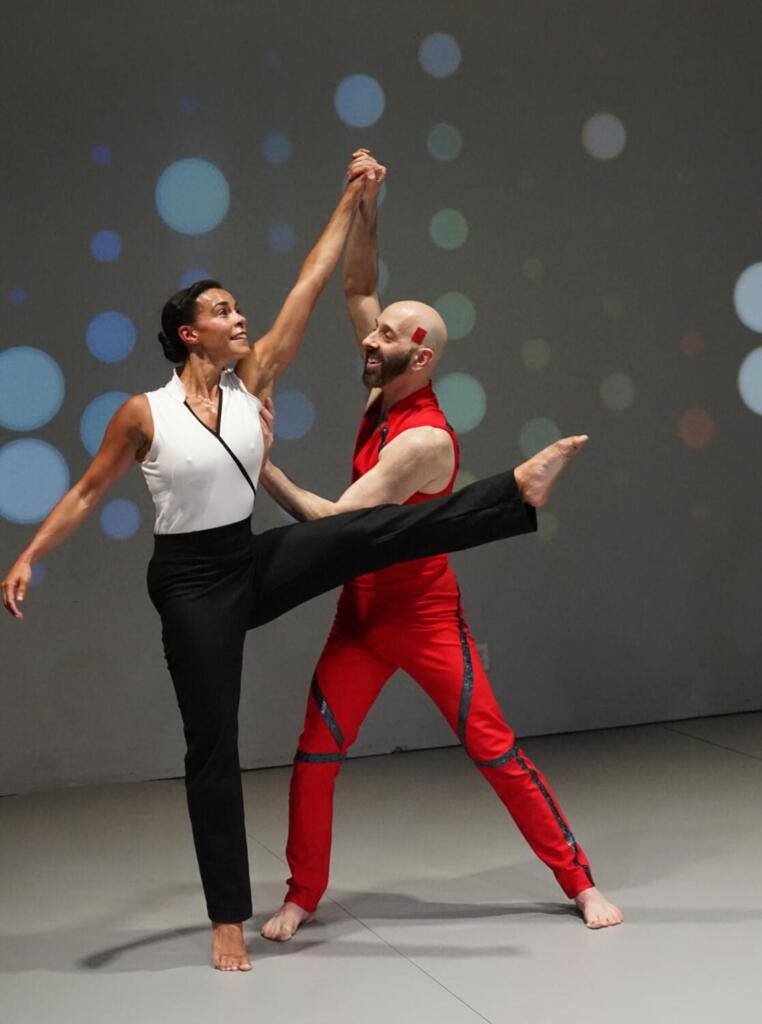
Daniel Gwirtzman Dance Company dancers Sarah Hillmon and Daniel Gwirtzman in e-Motion, co-conceived by Saviana Stanescu and Daniel Gwirtzman. Photograph by Stefanos Milkidis.
Hamilton: How did you collaborate with the dancer and choreographer Daniel Gwirtzman?
Stănescu: I recognize in my collaborator, Daniel Gwirtzman, a kindred spirit, a fellow traveler, in search of similar answers and questions. Our “Creature” is the dance theatre show e-Motion. The process of working on e-Motion has been unique because it’s led to the creation of a dance theatre piece, a hybrid that lives at the intersection of dance, theatre, visual installations, human-centered design, neuroscience, and computer science. When we started talking about this project, ChatGPT was not something we had access to. The research I was doing at that time was mostly connected to the neuroscience of emotions (a former neuroscientist boyfriend had introduced me to this fascinating field).
After OpenAI launched ChatGPT in November, 2022, I started—like many others—to chat every day with this AI product invented by an Eastern-European immigrant like myself, Andrej Karpathy. As I said, I asked ChatGPT many questions connected to our story. For a while I was paralyzed and couldn’t write anything myself, thinking that if ChatGPT was able to generate so much text, then what’s my role as a playwright? But after observing the dance sequences that Daniel choreographed, watching Daniel and Sarah beautifully embody the conceptual ideas, and seeing the amazing human bodies in motion, in e-motion, my human creativity kicked in again. After all, ChatGPT was repeating itself, offering tedious phrases. I could bring my unique brand of humor and irony to the story; I could write playful dialogue and insightful monologues reflecting my own poetic/dramatic writing style and connecting to the abstract movement Daniel imagined.
I had to work hard on distilling the lines to their essence because it’s a piece that incorporates dance (as the main element), digital projections, music, spoken word, coding language, AI dramaturgies, and playwriting—so each artistic medium needs to collaborate in telling the story without distracting the audience. Additionally, we had an interactive element in which the spectators converse with ChatGPT directly at the beginning of the show, while H is “restoring” his programmed balance. One could say that ChatGPT is an element in our show, a researcher that supported us, but I wouldn’t call it a playwright, or a dancer… Stay away from my job, AI friend!
Hamilton: How did you choose what kinds of designers and composers to work with?
Stănescu: The composer, the late Jeff Story, was a long-time collaborator of Daniel Gwirtzman Dance Company. Daniel wanted to pay tribute to his old friend who passed away during the pandemic.
So-Yeon Yoon is an associate professor of Design and Environmental Analysis at Cornell University. She was recommended to us, and Daniel and I went to meet her at Cornell. She got excited about the project and agreed to be a part of the team. She created the Data Capture/Projection design. The lighting designer and the stage manager—Ashley Crespo and Angela Lopes—are Ithaca College alumni.
Hamilton: How did you develop the repetitive language and mirroring structure which is expressed in the dialogue and the dance?
Stănescu: The process of working with Daniel Gwirtzman was organic; the text would inform the dance, and the dance would inform the text, as we developed e-Motion over a few months. Daniel would rehearse with Sarah in New York—I went there a few times too—and we made sure that the dance structure, the text, the music, the projections, functioned well together, in a way that didn’t distract from the beauty of the dance and the telling of the story. Sarah came to Ithaca for a workshop at The Cherry Arts, and we had a rough run of the entire piece. I realized that I needed to work more on the text, to essentialize the language and scientific knowledge, in lines that were potent, sophisticated, and economical. I really cared about having the best version of the script possible, to express the necessary scientific elements in a way that’s compelling and didn’t bore the audience, while offering enough information. Ava’s monologue, written in code-inspired technical language, worked unexpectedly well on stage. I did research into Python and Java++ programming languages, and I wrote the monologue like a spoken-word or rather spoken-code poem. It was really fun.
Hamilton: How did you decide on a non-linear storytelling format for ZEBRA 2.0?
Stănescu: ZEBRA 2.0 was publicized as a “mind-bending, heart-rending – and funny – transmedial performance experience,” engaging questions of artificial intelligence, humanity, belonging, consciousness, and reality. Its heartbeat is the story of the uncanny friendship between Zina (Moldovan actress Alina Mihailevschi), an undocumented immigrant, and AI (Tim Craig), who appears on a large computer monitor. Zina calls him AL because when she first sees his label “AI” she reads it mistakenly as “AL.” Over the course of 50 nights, AL the AI and Zina the Human bond and learn from/about each other. It’s an episodic structure that helps me organize my thoughts as well as the progression of the relationship between characters. It works well particularly with two-handers, and I’m realizing right now that all three pieces I mentioned—What Happens Next, ZEBRA 2.0, and e-Motion—have two characters and a dramatic structure that develops over a limited number of days/nights of the protagonists’ interactions.
Hamilton: What did you learn about writing code-inspired, technical language, and inventing a language style for a character who is an AI being?
Stănescu: It was exciting! The AI character needed to have some technical language and, in the case of ZEBRA 2.0, to be performed in a way that’s informed by technology.
In e-Motion, we went the other way, because a dancer embodies the AI. It’s a very interesting approach, I think. We have projections and even AI-generated visuals, but the AI is a dancer. E-motion is a constructed poetic word used to convey the main theme of the show: energy in motion, and a dance of emotions through the movement of flesh and bones. To paraphrase Ava’s line, “Maybe we, humans, are just super-sophisticated AI computing on organic matter instead of silicon chips.”
Hamilton: How did you learn about how scientists authentically interact with AI? How did you then develop that knowledge to interpret it on the stage, for instance, in the lines where ZINA talks to AL and teaches him his name?
Stănescu: I created a character who is an Artificial Intelligence (AI/AL) at a wildlife preservation company in the US, working on tracking zebras in Africa. I employed the algorithmic learning process of a real AI: processing large data and detecting patterns. It was very exciting to see AL come to life and actually grow as an AI, while becoming more and more “human.”
Of course, I took some creative liberties in shaping the story—it evolved in a more speculative way—but the core process of AI-human connection is based on scientific facts.
Hamilton: How did you collaborate with a data scientist in developing this play?
Stănescu: I was paired with the data scientist Niki Athanasiadou by Tjaša Ferme and the Science in Theatre Festival in New York City. We had a few meetings in Manhattan and by phone to discuss my ideas for a play about Artificial Intelligence and big data. Niki sent me various journal articles, and I researched others. I was particularly interested in a few features about pattern-recognition software to ID animals and tracking zebras in Africa, as I found during my research that, “each zebra’s black and white markings are like a fingerprint, distinct, and invaluable for scientists.”
Animator/video designer John J.A. Jannone, a professor of Television, Radio & Emerging Media at Brooklyn College, created the face of AL, the AI character in ZEBRA 2.0. AL was performed live on camera, from backstage, by actor Tim Craig. This is how John described his work to me: “A live camera image of the performer playing AL is fragmented into a cloud of 20,000 particles that are projected into a virtual 3D space displayed on AL’s [onstage] monitor.” John manipulated this particle cloud interactively during the performance, causing the fragments to flow together into a recognizable image, dissociate into noise, and warp into unlimited patterns and forms. He used this image-world to create a progression through the play from a highly abstract approximation of a human face through multiple permutations of increasingly recognizable humanity. Additionally, John’s software accessed a database of AI textual analysis of my script created by data scientist Niki Athanasiadou, which allowed the images on AL’s screen to be influenced by an AI language model’s “understanding” of the text/play. Hopefully, the AI won’t start “writing” in my style.
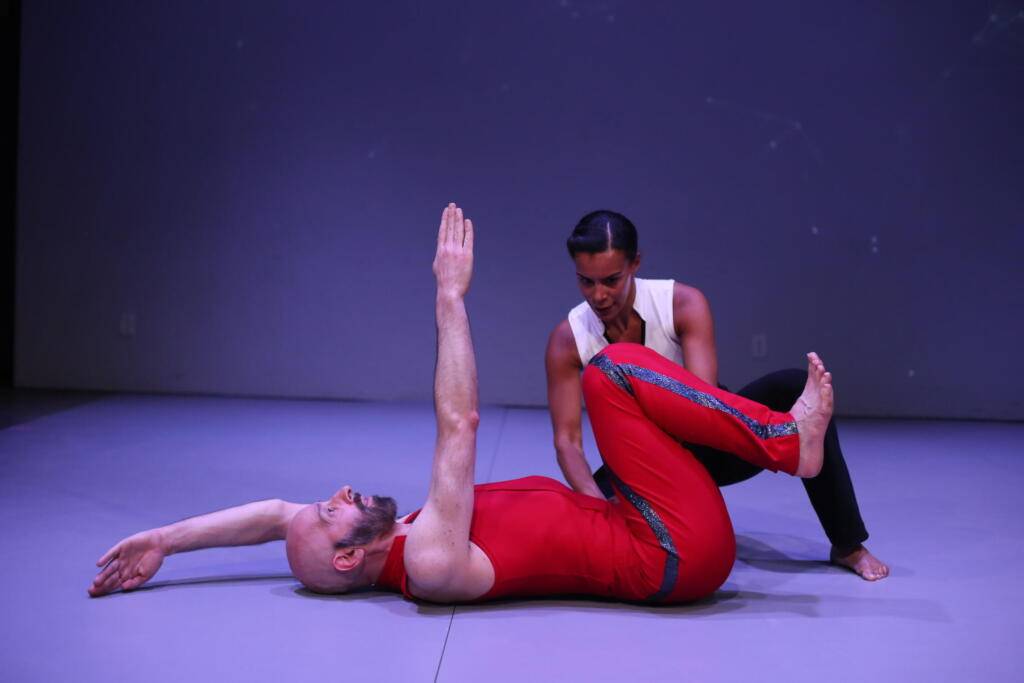
Daniel Gwirtzman Dance Company dancers Sarah Hillmon and Daniel Gwirtzman in e-Motion, co-conceived by Saviana Stanescu and Daniel Gwirtzman. Photograph by Katie Sims.
The Future
Hamilton: How did your understanding of AI change during the process of these productions?
Stănescu: Well, the WGA (Writers Guild of America) and SAG-AFTRA (Screen Actors Guild – American Federation of Television and Radio Artists) strikes influenced, of course, my thinking about AI.
Many playwrights write for TV. My friends were there in L.A., on the picket line.
The WGA recently obtained an agreement that states that AI cannot be used to undermine a writer’s credit or reduce a writer’s compensation. But the contract leaves room for Hollywood studios to train AI using preexisting material, and—people fear—replace human writers and actors. AI is learning fast from our collective human knowledge. Some scientists are pushing for regulations by saying that we should stop feeding copyrighted material to AI. Other people are happy to feed it anything, just to see how it develops/evolves. This could work against us, as artists. Colleagues are quite worried about AI taking over the entertainment industry.
AI is an alien form of intelligence that humans have created. It’s considered artificial, as compared to what? To the human brain/mind. We are responsible for continuously questioning and monitoring the ethical aspects of the AI-human interaction.
Hamilton: Where might you go from here as a playwright in treating these topics in the future?
Stănescu: To be honest, I don’t know yet. At this point, I’m excited to write human characters and a super-intelligent rat in the play I’m currently developing, Lab Rats, about the price animals pay for our human knowledge/progress. But I guess, AI might be a sort of lab rat as well, or maybe it’s the other way around, and we, humans, are being studied in a large simulation, run by superior AI.
Let’s not end on this dystopian note though—I’m happy to work on whatever stories my creativity encourages me to explore. I’ve always been a curious person, enthusiastic about learning new things. I’d love to write for TV or film next. I have another project that happens in virtual reality where we enter a painting and things happen there. I’m also working on a musical, and that’s cool too, because I’ve been discovering so many wonderful things via cross-cultural collaboration. In any case, I’m happy to work with AI in any ethical and fair way that doesn’t impact negatively human artists’ creativity and employment.
Hamilton: Thank you so much for taking time for this interview!
SAVIANA STĂNESCU is a cutting-edge Romanian playwright, poet, and ARTivist based in NY, author of Aliens with Extraordinary Skills, For a Barbarian Woman, Don’t / Dream, Bee Trapped Inside the Window, ZEBRA 2.0, What Happens Next, Ants, Lenin’s Shoe, Hurt, Useless, Toys, and other plays centering “outsiders”. Winner of New York Innovative Theatre Award for Outstanding Play (Waxing West) and UNITER Award for Best Romanian Play of the Year (Inflatable Apocalypse), Saviana has published over 15 books of plays/poetry, written in English or Romanian. Other honors: Indie Theatre Hall of Fame, John Golden Award, Fulbright, KulturKontakt, Marulic Prize for Best European Radiodrama, Inaugural Audrey Residency with New Georges, Richard Schechner’s ECA writer-in-residence, etc. Founder of Immigrant Artists and Scholars in New York (IASNY). savianastanescu.com.
This post was written by the author in their personal capacity.The opinions expressed in this article are the author’s own and do not reflect the view of The Theatre Times, their staff or collaborators.

